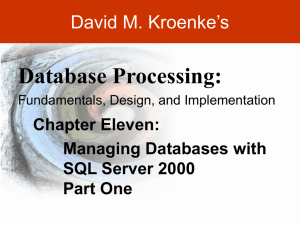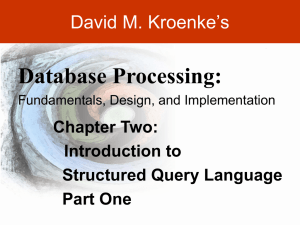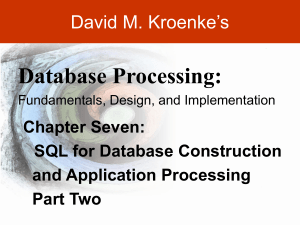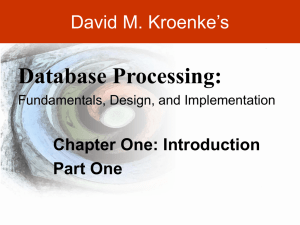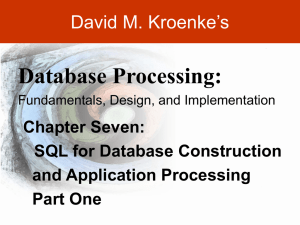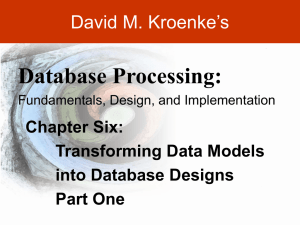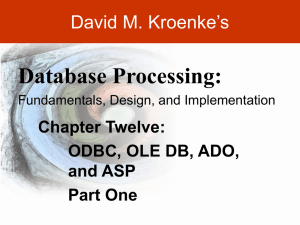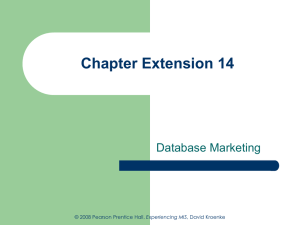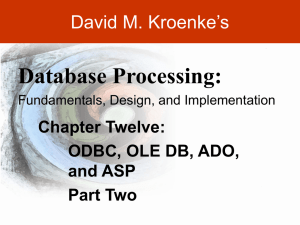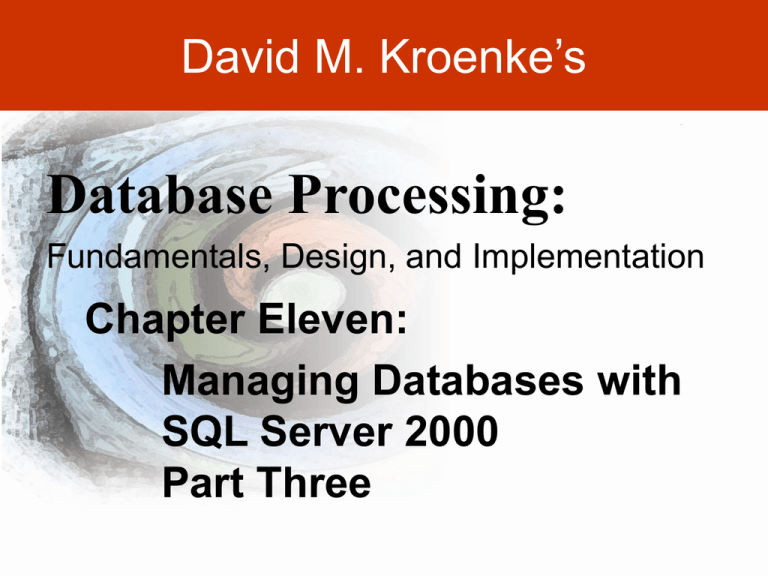
David M. Kroenke’s
Database Processing:
Fundamentals, Design, and Implementation
Chapter Eleven:
Managing Databases with
SQL Server 2000
Part Three
DAVID M. KROENKE’S DATABASE PROCESSING, 10th Edition
© 2006 Pearson Prentice Hall
11-1
Indexes
• Indexes are special data structures used to
improve database performance
• SQL Server automatically creates an index on all
primary and foreign keys
• Additional indexes may be assigned on other
columns that are:
– Frequently used in WHERE clauses
– Used for sorting data
DAVID M. KROENKE’S DATABASE PROCESSING, 10th Edition
© 2006 Pearson Prentice Hall
11-2
Indexes
• SQL Server supports two kinds of indexes:
– Clustered index: the data are stored in the bottom
level of the index and in the same order as that index
– Nonclustered index: the bottom level of an index
contains pointers to the data
• Clustered indexes are faster than nonclustered
indexes for updating and retrieval
DAVID M. KROENKE’S DATABASE PROCESSING, 10th Edition
© 2006 Pearson Prentice Hall
11-3
Creating an Index:
By GUI in Enterprise Manager
DAVID M. KROENKE’S DATABASE PROCESSING, 10th Edition
© 2006 Pearson Prentice Hall
11-4
Application Logic
• SQL Server database application can be
processed using:
– Programming language, e.g., C#, C++, Visual Basic,
Java, to invoke SQL Server DBMS commands
– Stored procedures
– SQL Query Analyzer to invoke database commands
stored in .sql files
– Triggers
DAVID M. KROENKE’S DATABASE PROCESSING, 10th Edition
© 2006 Pearson Prentice Hall
11-5
Stored Procedures
• A stored procedure is a TRANSACT/SQL (T/SQL)
complied program stored within the database:
– T/SQL surrounds basic SQL statements with programming
constructs such as parameters, variables, and logic structures
such as IF and WHILE.
• Stored procedures are programs that can:
–
–
–
–
Have parameters
Invoke other procedures and functions
Return values
Raise exceptions
• Creating stored procedures
– Write a stored procedure in a text file and process the
commands using the Query Analyzer, or
– Using Enterprise Manager
DAVID M. KROENKE’S DATABASE PROCESSING, 10th Edition
© 2006 Pearson Prentice Hall
11-6
Parameters
DAVID M. KROENKE’S DATABASE PROCESSING, 10th Edition
© 2006 Pearson Prentice Hall
Variables are declared
after the keyword AS
11-7
Triggers
• An SQL Server trigger is a T/SQL procedure that is invoked when a
specified database activity occurs
• Triggers can be used to:
–
–
–
–
Enforce business rules
Set complex default values
Update views
Implement referential integrity actions
• SQL Server only supports INSTEAD OF and AFTER triggers:
– A table may have one or more AFTER triggers
– AFTER triggers may not be assigned to views
– A view or table may have only one INSTEAD OF trigger for each
triggering action
• Triggers can roll back the transactions that caused them to be fired
DAVID M. KROENKE’S DATABASE PROCESSING, 10th Edition
© 2006 Pearson Prentice Hall
11-8
This is an AFTER
trigger on
INSERT on the
table TRANS.
It is will set a
default value on
AskingPrice.
DAVID M. KROENKE’S DATABASE PROCESSING, 10th Edition
© 2006 Pearson Prentice Hall
11-9
Triggers:
Enforcing a Required Child Constraint
There is an M-M relationship between WORK and TRANSACTION:
DAVID M. KROENKE’S DATABASE PROCESSING, 10th Edition
© 2006 Pearson Prentice Hall
11-10
Triggers:
Enforcing a Required Child Constraint
• The hard way
using two
triggers – this
one enforces
the required
child:
DAVID M. KROENKE’S DATABASE PROCESSING, 10th Edition
© 2006 Pearson Prentice Hall
11-11
Triggers:
Enforcing a Required Child Constraint
• The hard way
using two
triggers – this
one deletes any
duplicate
transaction:
DAVID M. KROENKE’S DATABASE PROCESSING, 10th Edition
© 2006 Pearson Prentice Hall
11-12
Concurrency Control
• Three factors determine the concurrency control
behavior of SQL Server:
– Transaction isolation level
– Cursor concurrency setting
– Locking hints provided in the SELECT clause
• Locking behavior also changes, depending on whether
actions occur in the context of transactions or cursors
independently
– Therefore, SQL Server places locks on behalf of the developer
– Locks may be placed at many levels of granularity and may be
promoted or demoted as work progresses
DAVID M. KROENKE’S DATABASE PROCESSING, 10th Edition
© 2006 Pearson Prentice Hall
11-13
Triggers:
Enforcing a Required Child Constraint
A better way - Create the Work_Trans view:
CREATE VIEW
SELECT
FROM
ON
Work_Trans AS
Title, Description, Copy,
ArtistID, DateAcquired, AcquisitionPrice
WORK W JOIN TRANS T
W.WorkID = T.WorkID;
DAVID M. KROENKE’S DATABASE PROCESSING, 10th Edition
© 2006 Pearson Prentice Hall
11-14
Triggers:
Enforcing a Required Child Constraint
• A better way
using one
trigger – this
one works
with the
Work_Trans
view:
DAVID M. KROENKE’S DATABASE PROCESSING, 10th Edition
© 2006 Pearson Prentice Hall
11-15
SQL Server Concurrency Options
DAVID M. KROENKE’S DATABASE PROCESSING, 10th Edition
© 2006 Pearson Prentice Hall
11-16
SQL Server 2000 Security
• SQL server provides two modes of
authentication:
– Windows only: the authentication is provided by the
windows operating system
– Mixed security: SQL Server will accept either the
windows-authenticated user name or it will perform its
own authentication
• Roles may be assigned to a SQL Server user
account:
– A role is a group of predefined authorities
– Public role has the authority only to connect to the
database
DAVID M. KROENKE’S DATABASE PROCESSING, 10th Edition
© 2006 Pearson Prentice Hall
11-17
SQL Server Backup
• SQL Server supports several types of backup:
– A complete backup makes a copy of the entire
database
– A differential backup makes a copy of the database
changes since the last complete backup
– Differential backups are faster and can be taken more
frequently
– Complete backups are simpler to use for recovery
• The transaction log also needs to be periodically
backed up
DAVID M. KROENKE’S DATABASE PROCESSING, 10th Edition
© 2006 Pearson Prentice Hall
11-18
Database Recovery
• Both data and log files are created by SQL
Server
• SQL Server provides a wizard for setting up
database maintenance plan, e.g., scheduling
database and log backups
• To recover a database with SQL Server:
– The database is restored from a prior database
backup
– Log after images are applied to the restored database
– At the end of the log, changes from any transaction
that failed to commit are then rolled back
DAVID M. KROENKE’S DATABASE PROCESSING, 10th Edition
© 2006 Pearson Prentice Hall
11-19
SQL Server Recovery Models
• Three recovery models
– Simple recovery: neither logging is done nor log
records applied:
• To recover a database is to restore the database to the last
backup
• This method can be used for a database that is never
changed
– Full recovery: all database changes are logged
– Bulk-logged: all changes are logged except those
that cause large log entries
DAVID M. KROENKE’S DATABASE PROCESSING, 10th Edition
© 2006 Pearson Prentice Hall
11-20
David M. Kroenke’s
Database Processing
Fundamentals, Design, and Implementation
(10th Edition)
End of Presentation:
Chapter Eleven Part Three
DAVID M. KROENKE’S DATABASE PROCESSING, 10th Edition
© 2006 Pearson Prentice Hall
11-21

